
THROUGH FRANCE ON BIKES AND TRAILERS (continued)
We found the suitcases tracked marvellously behind the bikes and often we weren’t even aware of them, unless we accidentally clouted something. We noticed it when we took them off – we flew! And we noticed it, when after flying, we attached them again! We don’t think we would ever try panniers; some who have tried both say you get fewer flats with the trailers because the weight is off the bike wheels.
A little bit about the bikes. They were (2004) New World Tourers and trailers. Tyres were Primo Comets on one bike, Schwalbe Marathon on the other. One had a thudbuster under the saddle. A Terry Liberator seat for Briar (her) and Specialized V-groove for Neil (him). H handlebars, SRAM 5.0 so 3x9 gears. Speedplay frog pedals.
Other gear included blue/white LED headlights (which strapped round our foreheads), one Etrex GPS, 2 CB radios, a Sierra 3-man tent with ¾ fly, a Bike Friday flag each, many Michelin maps, a digital camera with 10x optical zoom, and a Vosonic portable hard drive with capacity for about 20,000 photos. We were hence forced to take recharging gear for the numerous rechargeable batteries.
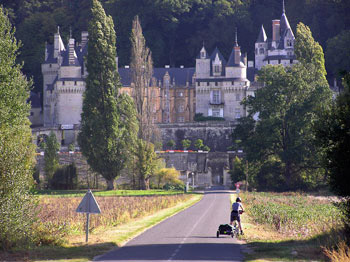
We had established that a Cateye wireless bike computer did not work reliably on Briar’s bike, perhaps because of antenna effects (the configuration of Briar’s bike frame appeared to act as an antenna, interfering with the signal) so we settled for one with a cord and had no problems.
We intentionally arrived after August 20, which is the “official” end of vacation in France and found things relatively quiet. Our purpose was part kilometers, part sightseeing. We did a long loop from Paris to the north-east and back. Then a big circuit south. (See the animated gif.)
About 2000 km, and much more by train and bus (often following the wild geese south to escape the indifferent weather). Accommodation Youth Hostels, camping grounds and the occasional hotel. Security for the bikes was generally very good. Youth hostels always seemed to put us on the highest floor possible, making us closer to God.
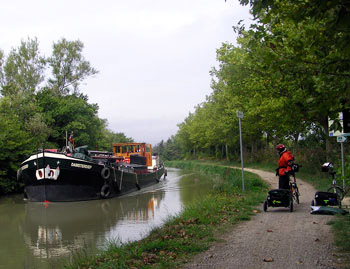
There are 2 classes of train in France: the TGV or fast long-distance train, and TER the slower (local/regional) trains. TER was best for bikes. Most TERs had at least one train per day with a “fourgon” (luggage van), in which you could hang bikes from large hooks (you had to be bit careful about the spokes!) Without a fourgon, you’ve got to fold the bike and wrap it up. We couldn’t find any of the bike covers (or “housses”) that the bike books talk about – even the bike shops and stations couldn’t help us - so we bought a “bache” at a local large hardware store - essentially a garden-use tarpaulin, and wrapped that round the folded bike, putting tough string through the eyelets on the edges, and closing up stray folds with a bungy cord. This also worked quite well for the TGV (fast trains). We found the folded, wrapped bike JUST fitted into the luggage compartments at the head of each carriage. (TGV insists on wrapping – very fussy!) The wheels had to come off the suitcase, along with towbar and axles. If you’re using TGVs the wisest thing is to start your TGV journey at the station of origin of the train because it gives you enough time to load. Trying to get everything on a TGV at a short stop is bedlam and next to impossible. The luggage compartment is usually full and the trains fairly loaded. On the occasions when you can get the trailers on board with wheels attached, loading and unloading onto any train we found was a pretty vulnerable time. The clovis/clevis pins tended to come off the axles when bumped! On one occasion one wheel fell off and rolled away down the platform. We managed to retrieve all bits that time, but eventually ended up having to use spare clovis pins and washers we had brought.
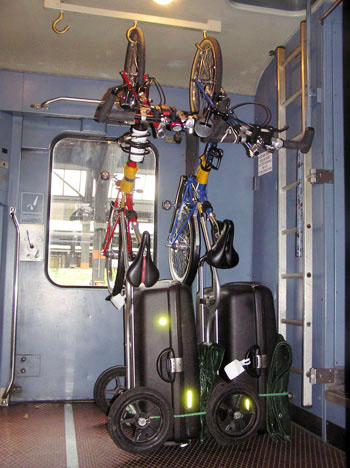
For TER trains with “fourgons”, we often found that we could load the trailers with wheels still attached. No-one complained, especially if we parked them vertically (with the towbar in the air). The greatest bugbear was numerous steps between platforms, though modern stations like Angers have blessèd ramps. The worst station was (very modern) Monaco! On routes trains didn’t run, the railways often ran buses from a bus-station (gare routière) near the train station. We found these usually had large storage bins underneath. Because these were non-profitable routes for trains, there usually weren’t a lot of people on the buses either. So we never had a problem finding room in the bins for the bikes (folded and wrapped in their tarpaulins) and the trailers, with the wheels and towbar still in place. We tried to wedge them in so things didn’t move around too much.
At train stations we were able to check the TER timetables for trains that took bikes (there was a small bike symbol for those trains) but it was imperative to check just how they took them. Sometimes that little symbol meant they would take bikes “as is” in the “fourgon”, other times that they would only take them folded – in which case they usually required the wheels also came off the suitcase. You just had to check early enough in advance that you had time to fold the bikes and de-wheel the trailer.
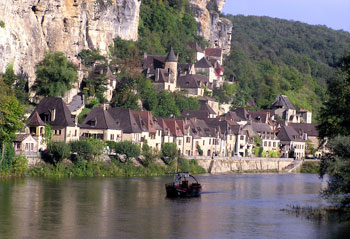
Travelling as a twosome gave us special security advantages. One of us was always able to keep an eye on bikes and trailers when they became separated during carting up and down stairways. When they were parked it was possible to tangle both of our tough 2m long security chains through both bikes, a trailer wheel each, the trailer handle and round a secure fixture. We just made sure there was no slack in the cable. (Also two bikes are harder to walk off with than one.) However for maximum security we threaded it also through the gear ring attached to the pedal shaft. When we were bedding down we often added the tarpaulin as a cover – it makes such a noise when it’s disturbed that it’s both a deterrent and an alarm system. Both bikes potentially fitted with us in the three-man tent, but this proved unnecessary. Bikes and suitcases stayed outside, and valuables were with us in the tent.
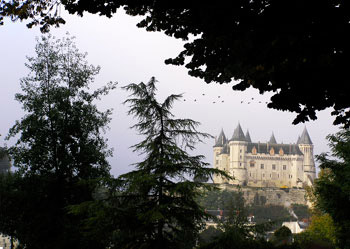
Briar wouldn’t have been able to do the trip alone. Handling the bike and trailer up and down the places we often had to go was sometimes beyond her; she wasn’t strong enough eg scores of stairs at train stations, 3-4 storeys up narrow staircases in youth hostels. If you’re solo, who looks after the bike while you’re carting the trailer…? there’s usually nothing to lock it to in underground passages.
We were each towing 20-25 kg of gear and only managed about 40-60 km a day depending on the amount of sight-seeing (and we planned so there was some each day!), the wind and the terrain. In spite of the large volume of the trailers we still had a minor amount of gear strapped outside on top (eg spare tyres under the folded tarpaulin, windjackets, handy towels) We were impressed how waterproof the cases seemed to be.
We were amazed that the Comet tyres did not seem at all worn after the trip, whereas the Schwalbe tyres were somewhat worn. Others seem to have found about the same. Our brake pads were practically non-existent.
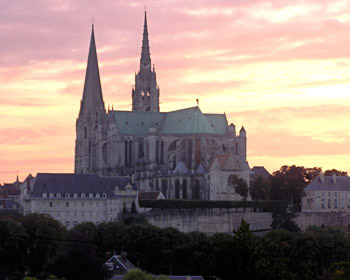
We had some problems attaching the flagpole to the Samsonite case – our fluttering fluorescent flag was important for visibility. We improvised reasonably effectively using the tough, serrated, plastic ties and the cheap plastic clamps for fixing reflectors to bike tubing. We put a strip of inner tube round the axle underneath the clamp (between the side of the case and the wheel), tightened the clamp screw (after having drilled a hole for the pole in the extension to the clamp attachment). It stayed pretty firm, and we wrapped our elastic bungy cord (which went round the case) around the pole in the process. We were always having to pull the pole out when we were boarding trains and going up stairwells in youth hostels and hotels. We lost the lower part of one pole between a train and the platform – beware: metric sizes in France will not readily substitute. It's not worth wasting time looking for replacements.
At some stage (it’s not clear how) the trailer connection on Neil’s bike began to steadily bend downwards. We don’t know why; his trailer was not over-loaded at all. This eventually severe angle stripped the thread in the nut holding the connection to the bike frame. Moral – make sure the connection stays level and doesn’t start dipping down. But we think this may have been a manufacturing fault and wonder if the connection is a bit on the flimsy side for long trips. Bike Friday say, No, so we might have had a freakish situation. Fortunately we found a French machinist in the remote small town where the trailer finally fell off and refused to stay connected. He made a new nut (drilled a rod and threaded it) and welded it on within 45 minutes, at what he implied was a totally illegal workshop. This was surprisingly cheap, but it was not till a week later we realized his oxy-acetylene torch had brushed a spoke and melted it! It broke. Trivial to put in a new spoke, but balancing was rather expensive. (By the way, make sure you take your BF spokes with you. The bike shops we visited didn’t have them.) And if your trailer nut strips, it’s doubtful you’ll find one in France; like us you’ll probably have to find a machinist.
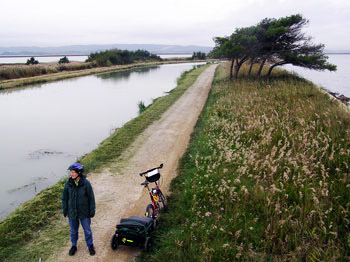
To our horror, after storing 600 digital photos (representing our first 6 weeks!) our portable hard disk crashed. This proved due not to jolting in the trailer, but failure of an internal IC. (We suspect it suffered irreversible damage when the suitcase was thrown round by handlers at an airport, mentioned earlier. It was cushioned well in the suitcase but we should have had it with us in the cabin.) Attempting to retrieve the photos was expensive, requiring the special services of an expert disc crash retrieval expert, who gave us a lot of his labour free because he didn't want the thing to beat him. But he finally had to give up on it. (A brand-new hi-tech way of losing your precious holiday pix!) We reverted to burning to CD at Internet cafes where possible.
We found French drivers to be, in the main, very courteous. We avoided main (departmental) routes where possible and stuck to back roads and bike routes, not that we came across many bike paths. Sometimes we were pedestrians, riding along footpaths/sidewalks, mostly we were vehicles, riding on roads. We suffered a mishap when we went through a road closed sign and, encouraged on by the roadcrew, found ourselves on tar which hadn’t quite dried. We collected a lot of tar, stones and gravel on the tyres of bike and trailer, which made riding impossible and which we had to remove in a hurry. Fortunately we were close to a tiny settlement where a kind French woman gave us detergents and hot soapy water so we could scrape the tyres clean with a knife. It still took about 2 hours.
We had a rather amazing experience, open to any cyclist, in the south on the Mediterranean. The freshwater canals there are often built through the middle of large saline coastal (sea) lakes, mined for salt in Roman times. There are towpaths alongside the canals. A great cycling experience through the sea!! Very odd indeed, and the flamingoes make it even more exotic. We also thoroughly recommend the Canal through the Vosges mountains which takes you hassle- free into the center of Saverne, 200 m from your Youth Hostel. However you need to be selective – some rougher canal paths are downright hard work.

We found La Rochelle rather confusing in the suburbs even with maps. The Loire was easy cycling, but less interesting between the chateaux than we expected. The Moselle R is easy cycling, interesting, but not gripping. The Wine Trail near Colmar - including Riquewihr and Ribeauville is very touristy, but beautiful. The route from Munster to Col de la Schlucht and back along the bikepath to Colmar was superb.
We met only one person who recognized the Bike Friday, but the bike/trailer combo generated a great deal of interest and comment. Because we speak French reasonably well, we got into a lot of conversations because of the bikes, and most people wanted to know where they were made, and knew enough English to read the Bike Friday logo on the bike frame. Most people couldn’t believe we were going the distances we were on such small wheels. Their eyes popped at the number of gears. When we explained that the bike folded and fitted in the trailer for travel and that the suitcase became a trailer on the trail, they thought it was ingenious! We were told we were mad, we were told our setup was thoroughly practical; we heard everything.
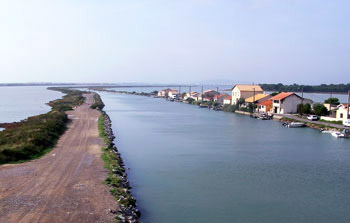
It was a great trip. The weather was not kind to us. The previous summer was a heatwave, this one was cool, mostly overcast and increasingly wet - even in Monaco at the end of October. But we met a lot of people, had some significant conversations, and interesting experiences, and saw great sights. We found muscles we didn’t know we had before. We didn’t actually lose any weight – we ate well but aren’t gourmands. We didn’t gain any weight either. We did our own cooking on a small stove we carried in the trailer, and rarely ate out, though bought light lunches. Two and a half months is a long time to be on the road, maybe slightly too long, but we tried (not very successfully) to have rest breaks! It was always good to be on the move again. We rarely stayed more than 2-3 nights anywhere- though on arrival stayed with friends for 6 days – while we checked bikes, replaced a brake cable which had got crushed in transit, looked for the elusive “housse"/bike bag (which, as mentioned earlier, we never found), generally adjusted to the time difference (we were 12 hours displaced, coming from New Zealand), and waited for the weather to improve (it didn’t) and we started our trip in steady light rain.
We had left our backpacks with our friends in Paris on arrival, and we picked them up again when we flew out. At the end of the trip they offered us their apartment in Paris for 3 days while they went off to their “residence secondaire” in a small country village. At that point the bikes went back in the suitcases and the contents of the trailers returned to our backpacks.
We flew back through the USA (to keep our luggage allowance high as mentioned), to see friends in Denver and do a bit of business there. We had hassles with security in Denver on the outward flight - as mentioned. Everything was OK when we arrived back in NZ – though we almost got a $200 fine for failing to declare some ancient dog poo found on the bottom of one of our cycling shoes. (Funny how some wandering dog in Paris can almost leave you out of pocket in NZ!) NZ customs can get rather officious about organic matter!
It was a great trip. Like all trips, you have to be prepared for some stressful moments. Not every official wants to make your journey easy, sometimes you’re wet through, tired, sore and can’t track down your accommodation. In the main we found the French helpful, and friendly when we were friendly. We have loads of photos – and we’ll would have had a lot more if our expensive data retrieval expert had managed to get them off the hard disk ... The bikes stood up to the hammering very well. We wouldn’t swap them for anything.